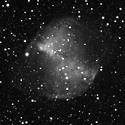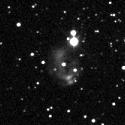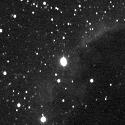
Bubble nebula = NGC7635
Composition of 60 x 20 sec exposures, offset, dark and flat corrected with IRIS v5.57
Sigma clipping addition, personal software based on CFITSIO
The slightly noisy aspects come from the logarithms used in the processing, to avoid saturation of the bright parts of the nebulae. In both cases, the signal-to-noise ratio was quite good. Limit magnitude is now around 17.7 according to Astrometrica : as compared to my previous M27 picture (see below), improvement in magnitude comes from (1) sky more transparent with less cirrus clouds (2) higher declination of observed object (3) longer exposure times for individual acquisitions, that reduces read-out noise.




